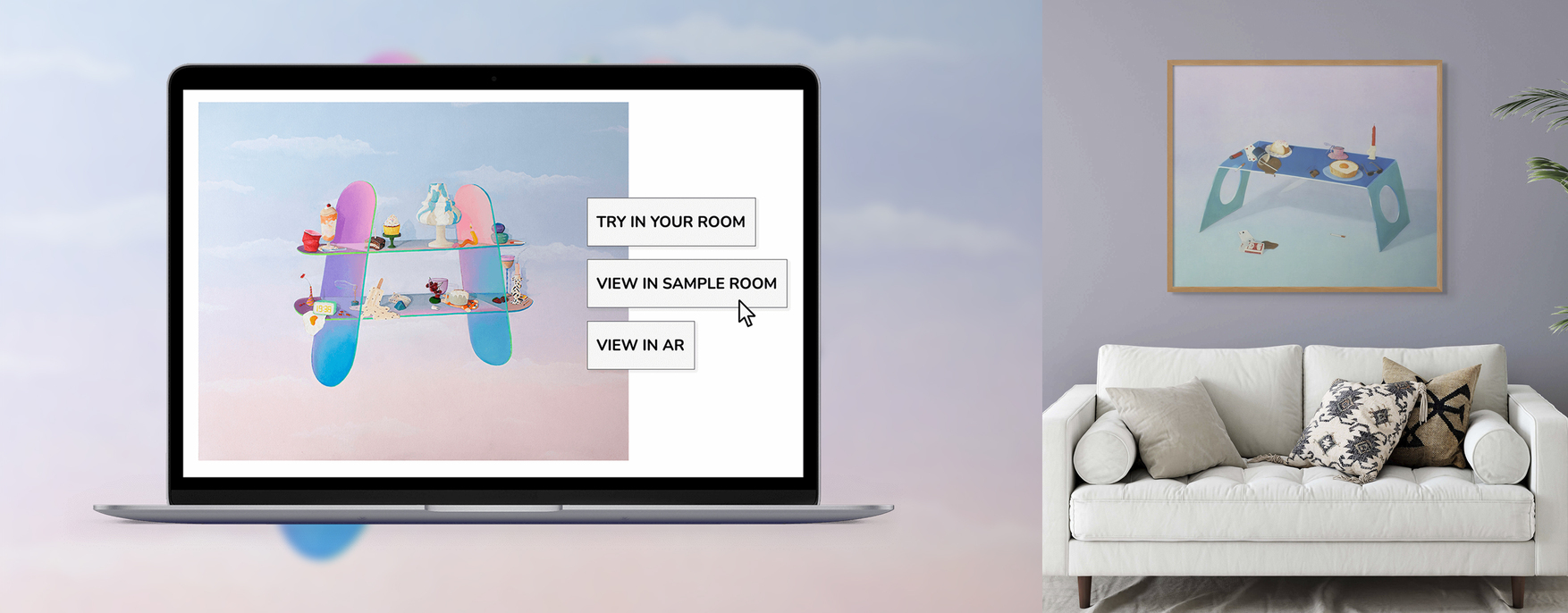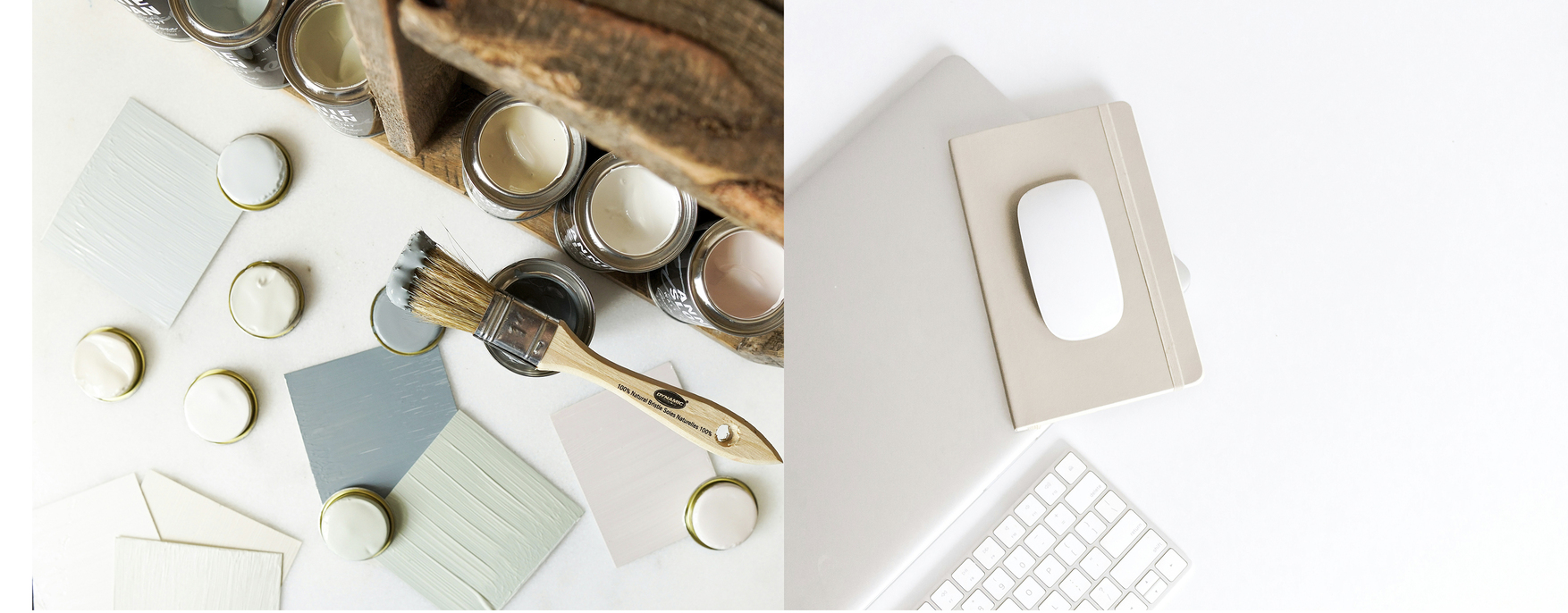Whether you’re an artist looking to showcase your work to a global audience or a gallerist aiming to expand your reach beyond the boundaries of an in-situ business, starting an online art business can be the key to unlocking the path to success and taking control of your career.
Given that the digital landscape is always evolving, the options for starting an online art business in 2025 are endless. There is no fit-for-all formula, but in this article, we will cover the pillars of what it means to build an art business with growth and profitability as the goals.
This guide will explain the key steps to building and growing a successful online art business, helping you navigate the challenges of the modern art world.

Your business model will define the path your online art business will take and give you extra focus.
Contents
Where to start: define an online art business model
There are two paths when it comes to defining a business model for your online art business. Do you want to curate and sell your own art or work with the artworks of a group of artists you will be promoting? This question will help you clarify which direction you can move forward in. The next question has a lot to do with the processes you will be in charge of: do you want to sell original artworks or fine art prints?
Take note of your answers because these two elements will define your business model. With these answers in mind, you need to establish the following pillars to define your business model properly:
–Mission and vision: what is the core purpose behind this project? What motivates you, and what value are you providing to the artistic community?
–Who’s your audience? Define your audience by location, age, income, and interests. This will define your target audience.
–Unique selling proposition: this marketing term will help you understand what sets your art or your collections apart from others available in the same market.Choose your sales channels: will you be using an existing art e-commerce, your own professional website or will you use your social media profiles as a sales channel?
Now, let’s review some of the most common models for art businesses:
–Direct sales model: in this kind of business, the income is generated from the direct sale of individual pieces or limited edition prints to collectors through an e-commerce or personal website. This will be one of the examples we will use throughout the article.
–Commission-based model: for artists, the revenue generation comes from a commission fee for the customized artwork, plus, the value of the piece itself. For galleries, the biggest profit comes from the fee attached to every sale of commissioned art made through their website.
–Print-on-demand model: the artist or gallerist earns a markup for each sale made when a collector orders a print. The third-party service used for printing usually earns a fee for this process.
–Auction model: artworks are sold in online auctions where customers can place bids. The revenue comes from the highest bid, and galleries might take a percentage of the total sale.
–NFT (Non-Fungible Token) Model: this consists of selling digital artwork as unique verified pieces through an NFT in a blockchain platform. Revenue comes from the sale of NFTs and royalties.
The next step in this journey is defining your business plan.

Your business plan is the blueprint to achieve the goals you have set up for your art business.
Creating a business plan for your online art business
A business plan is a stepping stone to starting your business. It gives you the focus you need to streamline processes and achieve goals like X quantity of art sales or X amount of revenue.
How can you build a business plan as an artist or gallerist? Answer the following questions and take notes:
–What are your financial goals for the first year of your business? Establish specific goals within this time frame, for example, the amount of artwork or prints you want to sell, how many commissions you will have, and how much you expect to generate in profit.
–Establish your resources: here, you need to list everything you need to get the wheels in motion with your business, from art tools to renting a studio to your own and your teammate’s salary. Define how much you need to invest to start and how you will finance this, as well as when you expect to see the return on that investment.
–Define a marketing strategy: how will you promote your art business? What art marketing tools will you use, and how much will you invest?Streamline essential processes: for example, if you want to work with prints-on-demand models, you will need to define which third-party service you will use, as well as number of editions, packing and shipping. You also need to define payment options for the artworks and have a clear understanding of any additional fees this might bring which should be shown in the artwork product page at point of sale.
Cory Huff from The Abundant Artist says, from experience, that you can summarize the whole process of writing your business plan in just a one-pager and work your way through more specific details as you advance in your journey to creating your online art business.

Pricing your artwork is an essential part that will give structure to your art business.
Pricing your artwork to escalate your art business
Once you have your business plan, you need to figure out a pricing structure that can make it a reality. There are several ways you can approach pricing your artworks. For example, if you are working with originals, you can price by the hour working on the pieces or by the number of inches and the size of the artwork. Other people start their pricing structure by defining a basic salary for them as an artist or as the lead of the art business.
Take into account that the pricing should also cover everything that has to do with the materials and medium used in the creation of the piece. If you are working with fine art prints like giclée, your price should also cover the printing process, paper and inks. You need to also define what add ons you will have like framing and matting, and how much will this add to the final value of the pieces.
Another thing you have to take into consideration when pricing an artwork is your experience or the experience of the artists whose artworks you are marketing, as well as the price of previously sold pieces. All of this will give you a better idea of what the right price range for the piece is. It’s always advisable to have a set of artworks at different price ranges to appeal to both new and seasoned collectors.
How to prepare your website to boost your online art business
Your website will be the home of your online art business, and as such it should be optimized not only to be findable by search engines, but to provide an attractive and engaging user experience that converts visitors into art buyers.
These are some elements that will ensure that your professional art website will organically push visitors from awareness to interest and then purchase:
-Have a strong brand image: highlight your artistic or curatorial view with brand elements that are visually appealing, such as images of the artwork placed in digital art rooms.
-Curate the artworks into separate categories visitors can explore according to their interest: collections or themes, subject matter, size, etc. Each collection should have its own page and offer the opportunity to open a new tab to learn more about each single artwork.
-Give visitors an engaging experience with “try-before-you-buy” art visualization tools.
-Create a Virtual Exhibition showcasing your artworks in a stylish 3D digital gallery.
-Have an integrated e-commerce plug in or service that will create a seamless purchase process. This includes integrating different paying methods like digital one-click options, or traditional credit and debit cards.
-Set up options for packing and shipping at different price points.
Check the full list of essential elements that compose a high-selling e-commerce art website.
How to generate leads and grow your art business
A key aspect of growing your art business is generating leads or connecting with a new audience of people who have expressed their interest, via word or action, in acquiring one of your pieces.
With ArtPlacer’s lead-generating tools, you can turn your Virtual Exhibitions and Online Portfolio into lead magnets that easily capture contact data from potential leads. From then on, the work is nurturing these leads with valuable content and timely emails to push them further in their art buyer journey and convert them into actual collectors.
Begin generating leads and connecting with potential collectors: start your ArtPlacer free trial today.
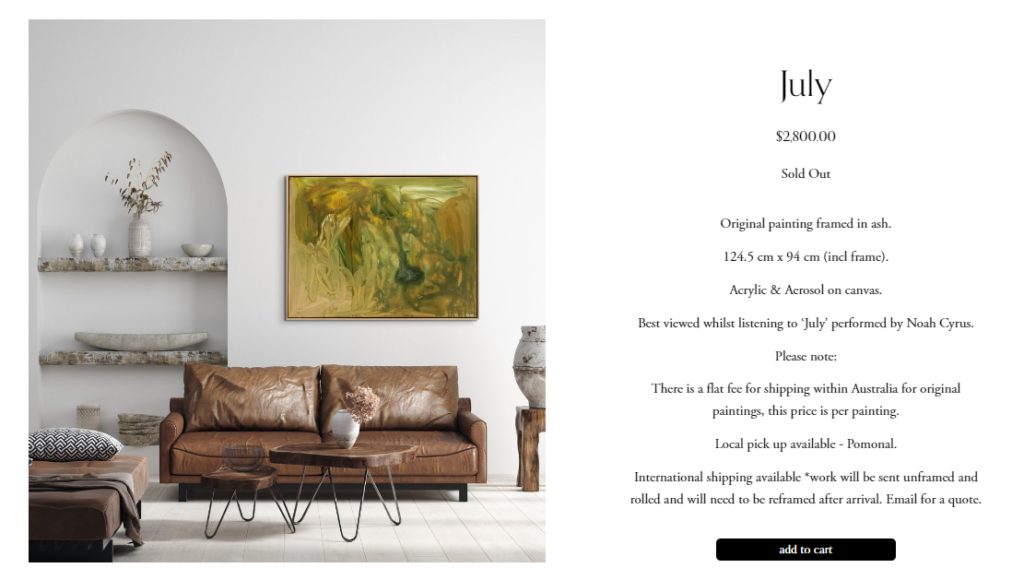
Example of an artwork product page and description by artist Rebekah Freeman.
Create an artwork product page that drives sales for your business
Now that your website meets industry standards, the next item on your list should be creating a product page for each artwork that will be available for purchase. What is an artwork product page? It is a single page hosted inside your website that shows a product along with all the information a buyer needs to know, plus action-driven elements that will help them complete a purchase process.
An artwork product page can help you close a deal or not. It all depends on how optimized it is to showcase the right information about the piece, including details like size, subject, medium, and more, that will help the art buyer make an informed purchase decision.
What makes a good artwork product page? Check this list of must-haves:
-High-quality images of the artwork, including lifestyle images of your pieces in different settings. You can use ArtPlacer’s Room Mockups to showcase your art at scale in exquisite rooms.
-A sales-focused and SEO-enhanced meta title, page meta description, and artwork description that will make your work findable on search engines. You can rely on tools like ChatGPT to help you with this.
-Essential details like medium, material, size, subject, and technique.
-Frames and mats (if available).
–“Try-before-you-buy” art visualization plugins that allow visitors to see your art on their walls in real size with the help of Augmented Reality Technology.
-Shipping information and return policy
-“Buy” button and digital payment options.
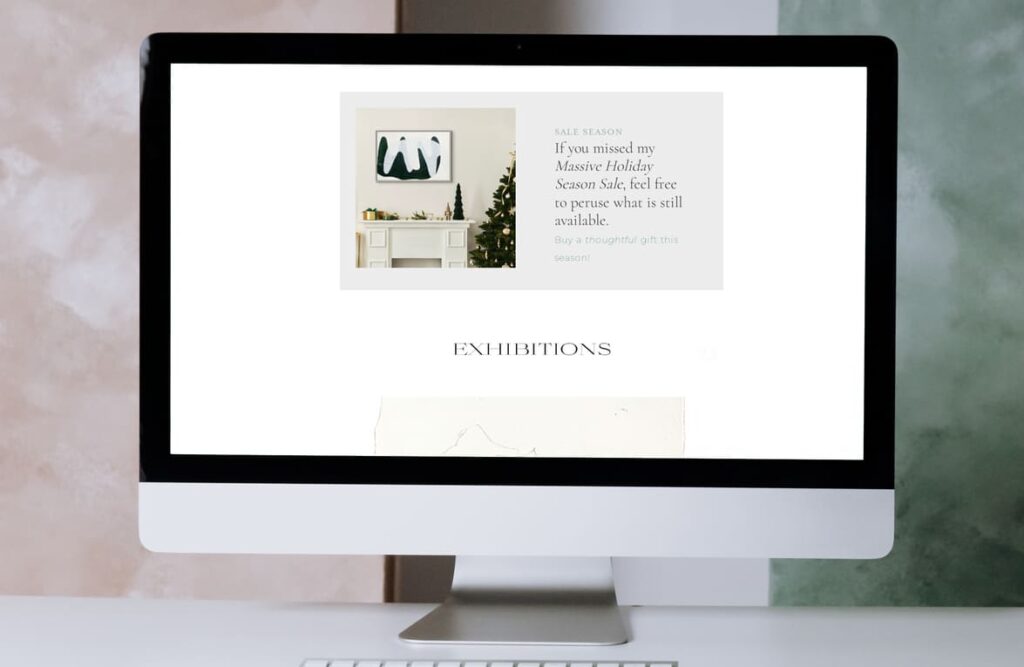
A newsletter is an excellent way to keep your audience in the know about your art business and strengthen a bond that can lead to art sales.
Using email marketing to grow your art business
Once your website is ready to be shared, it’s time to think of the art marketing strategies that will get you the organic traffic you desire. Email marketing is an essential part of any plan moving forward. It will help you build a loyal customer base and establish direct communication with art buyers.
You need to cover two email communication campaigns. First, you need to design responsive or transactional emails that accompany the art buyer through each step of the buying process, from “purchase confirmation emails” to “shipping details.” You can rely on a third-party email hosting service, but remember: it’s important to customize this journey to make it feel as personalized as possible.
The second campaign is based directly on promotion. This is your chance to showcase all the work you have been doing in the studio and your online art business. The idea is to make different marketing efforts or timely emails to create sales and inquiry opportunities. For example, a good strategy to engage visitors is offering a small discount on their first purchase if they subscribe to your mailing list.
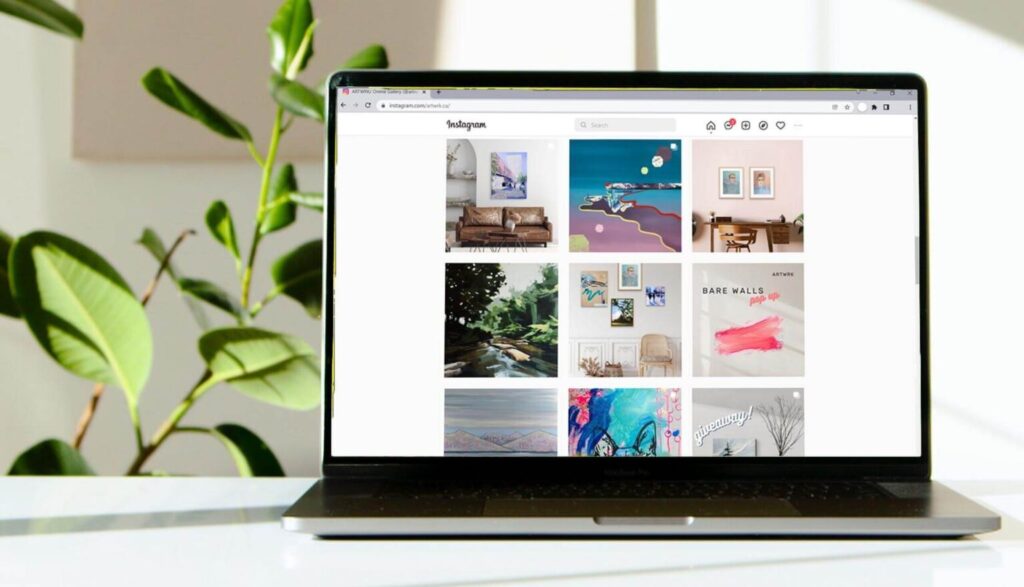
Your Instagram profile is a window into your world as an artist, gallerist, or curator. Room Mockups created with ArtPlacer.
Promoting your online art business on social media to achieve your sales goals
Social media marketing is a key factor for an online art business that can move the needle and help you reach your sales and profit goals. From Instagram to TikTok and other available channels, these work as a window to showcase your art in a more personal way, creating interactions that can lead to an art sale.
Each post is an excuse to strengthen your art business’s brand, create engagement with your audience, and expand your reach to a global market. These visual platforms are all about the storytelling behind the artworks and the artists.
People today not only buy a piece of art; they buy something that represents them, something that highlights their aesthetic, lifestyle, and unique points of view. When thinking about what to post on social media to promote your online art business, you need to have this in mind: your audience wants to know what happens backstage and build a connection with you.
Now that you know how to start an online art business, get working and launch yours according to the best practices for 2025.

